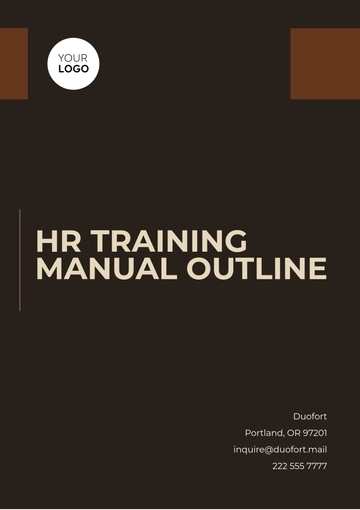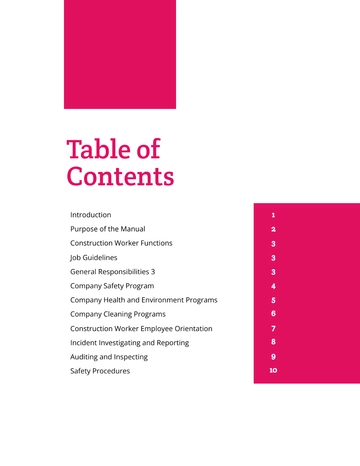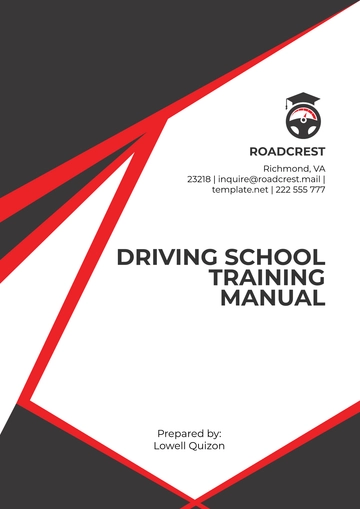Free Financial Cost Management Training Manual

I. Introduction to Financial Cost Management
Importance in Business
Financial cost management is pivotal for any business aiming to maximize profits and sustain growth. It plays a crucial role in shaping a company's strategic decisions and operational efficiency. Effective cost management not only helps in reducing unnecessary expenses but also in allocating resources optimally, enhancing profitability, and maintaining a competitive edge in the market. In today’s dynamic business environment, a company’s ability to manage costs effectively can be the difference between thriving and merely surviving. This process involves a deep understanding of all cost-related aspects of the business and making informed decisions to drive financial success.
Basic Principles
The foundational principles of cost management are essential for effective financial oversight. It begins with cost identification, which involves pinpointing all expenses incurred in the business operation. Following this, cost allocation assigns these expenses to different departments or products, providing clarity on where resources are being used. The final principle is cost analysis, which scrutinizes these expenses to understand their impact on the company's bottom line. This process enables businesses to identify areas of inefficiency, opportunities for savings, and strategies for optimal resource utilization. Understanding these principles is key to developing a robust cost management strategy.
Overview of Process
The cost management process is a systematic approach that begins with the initial assessment of a company’s current financial standing. This involves analyzing existing expenses, revenue streams, and profitability margins. Following this, a detailed plan is formulated to address identified areas of cost inefficiency, which may include renegotiating supplier contracts, optimizing operational processes, or restructuring budgets. The implementation phase puts these plans into action. Finally, ongoing monitoring is critical to ensure that these measures are effective, allowing for adjustments as needed in response to changing business environments or market conditions. This end-to-end process is cyclical, ensuring continuous improvement in cost management practices.
II. Understanding Cost Types and Behavior
This section delves into the various types of costs and their behaviors, detailing their characteristics, differences, and impacts on business operations.
A. Differentiating Costs
Explore the characteristics of fixed, variable, and semi-variable costs, and how they impact business operations.
Type of Cost | Description | Sample | Impact on Business |
Fixed Cost | Costs that do not vary with production level. | Lease payments for office space. | Predictable, aids in budget stability. |
Variable Cost | Costs that vary directly with production level. | Raw material costs for manufacturing. | Fluctuates with business activity. |
Semi-Variable Cost | Costs that have both fixed and variable components. | Utility bills (fixed base rate plus usage charges). | Partly predictable, partly varies with usage. |
Direct Labor | Labor costs directly associated with production. | Salaries of assembly line workers. | Directly linked to product output. |
Indirect Labor | Labor costs not directly tied to production | Salaries of administrative staff. | Necessary for supporting operations. |
Direct Materials | Materials used directly in the production process. | Steel used in car manufacturing. | Integral part of production cost. |
Indirect Materials | Materials not directly traceable to the product. | Cleaning supplies for the factory. | Supports production indirectly. |
Step Fixed Costs | Fixed costs that change at certain activity levels. | Hiring additional supervisors at higher production levels. | Remains fixed until a certain threshold. |
Depreciation | The allocation of the cost of an asset over its useful life. | Depreciation of machinery. | Affects financial statements, not cash flow. |
Interest Expenses | Cost of borrowed funds. | Interest payments on a business loan. | Impacts financial costs and profit margins. |
B. Direct and Indirect Costs
Delve into the distinction between direct costs, which can be directly attributed to a product or service, and indirect costs, which support business operations more broadly.
Direct Costs | Description | Indirect Costs | Description |
Production Supplies | Materials used directly in manufacturing. | Building Maintenance | Costs for maintaining the facility. |
Direct Labor | Wages of employees directly producing goods. | Utilities | Electricity, water, and heating for the building. |
Manufacturing Overhead | Direct costs of manufacturing excluding labor and materials. | Administrative Salaries | Salaries for non-production staff like managers. |
Shipping Costs | Costs of delivering products to customers | Depreciation | Allocation of asset costs over their useful life. |
Direct Material Costs | Raw materials used in production. | Marketing Expenses | Costs of advertising and promoting products. |
C. Cost Behavior Impacts
Understand how cost behavior influences managerial decision-making, particularly in response to changes in business activity levels.
Influence/Impact | Description |
Production Volume | Higher production often decreases per-unit variable cost due to economies of scale. |
Seasonal Fluctuations | Certain costs, like utility bills, may increase in certain seasons due to heating or cooling needs. |
Technological Advancements | Can lead to reduced variable costs through more efficient production methods. |
Market Conditions | Economic downturns can impact both fixed and variable costs, especially if downsizing becomes necessary. |
Pricing Strategy | Understanding cost behavior is crucial for setting competitive and profitable pricing. |
Financial Planning | Knowledge of cost behavior aids in more accurate budgeting and financial forecasting. |
Operational Decisions | Decisions regarding outsourcing or insourcing are influenced by the nature of the costs involved. |
III. Budgeting and Forecasting
This section covers the key aspects of budgeting and forecasting, detailing their principles, various techniques, and methods for variance analysis.
A. Principles of Budgeting
Covers the essentials of creating a comprehensive budget, including allocation of resources and setting financial targets.
Principle | Description | Sample | Potential Outcome |
Realistic Goal Setting | Setting achievable financial targets based on realistic assessments. | Setting a 10% increase in revenue based on market analysis. | Guides realistic resource allocation and expectations. |
Flexibility | Ability to adjust the budget as circumstances change. | Allocating contingency funds for unexpected expenses. | Ensures adaptability to changing business environments. |
Inclusiveness | Involving different departments in the budgeting process. | Department heads contributing to their budget creation. | Enhances accuracy and commitment to the budget. |
Prioritization | Allocating resources based on strategic priorities. | Prioritizing R&D spending for a tech company. | Ensures critical areas are adequately funded. |
Monitoring and Review | Regularly reviewing budget performance against actuals. | Monthly financial meetings to review budget variances. | Allows for timely adjustments and financial control. |
B. Forecasting Techniques
Techniques for accurate financial forecasting, utilizing historical data and market trends.
Technique | Description | Pros | Cons |
Trend Analysis | Analyzing past financial data to predict future trends. | Utilizes existing data for predictions. | May not account for sudden market changes. |
Scenario Planning | Considering different future scenarios and their financial impacts. | Prepares for various potential outcomes. | Can be time-consuming and complex. |
Econometric Models | Using economic indicators to forecast financial outcomes. | Incorporates external economic factors. | Requires expertise in economic analysis. |
Delphi Technique | Gathering and synthesizing expert opinions for forecasting. | Utilizes expert insights for accuracy. | Subject to biases and differing opinions. |
Sales Pipeline Analysis | Forecasting based on the current sales pipeline and conversion rates. | Directly linked to potential revenue. | Dependent on sales team's performance accuracy. |
C. Variance Analysis
Methods for monitoring budgets, analyzing variances, and implementing corrective measures.
Method | Description | Sample | Benefits |
Actual vs. Budget Comparison | Comparing budgeted figures with actual expenditures. | Comparing budgeted sales with actual monthly sales. | Identifies areas of over or under-spending. |
Ratio Analysis | Using ratios like expense-to-revenue to analyze variances. | Calculating the expense-to-revenue ratio for cost control. | Provides insights into overall financial efficiency. |
Volume Variance Analysis | Analyzing the impact of changes in operational volume. | Assessing how increased production volume affects costs. | Helps understand the impact of scale on expenses. |
Efficiency Variance Analysis | Evaluating the efficiency of resource utilization. | Analyzing labor hour variances against standard hours. | Highlights areas of operational inefficiency. |
Flexible Budget Variance | Comparing actual results with budgets adjusted for actual activity levels. | Adjusting budgeted costs based on actual sales volume. | More accurate assessment of performance against budget. |
IV. Cost Control Techniques and Strategies
This section elaborates on the various measures, methods, and best practices for effective cost control at [Your Company Name].
A. Cost Control Measures
Strategies for maintaining cost control, such as waste reduction, process optimization, and supply chain management.
Measure | Description | Benefit |
Waste Reduction Initiatives | Implementing strategies to minimize waste in production and operations. | Reduces unnecessary expenses and environmental impact. |
Process Optimization | Streamlining operational processes for efficiency. | Enhances productivity and reduces operational costs |
Supply Chain Management | Optimizing supply chain logistics and vendor relationships. | Lowers procurement costs and improves delivery timelines |
Energy Management | Adopting energy-efficient practices and technology. | Decreases utility costs and promotes sustainability. |
Regular Financial Audits | Conducting audits to identify inefficiencies and overspending. | Ensures accountability and financial transparency. |
B. Reducing Costs
Methods for reducing both operational and capital costs without compromising quality or business growth.
Method | Description | Potential Outcome |
Outsourcing Non-Core Functions | Delegating peripheral activities to specialized external firms. | Reduces internal costs and focuses on core competencies |
Technology Automation | Integrating automation tools to reduce manual labor costs. | Increases efficiency and reduces labor expenses. |
Strategic Sourcing | Sourcing materials and services at optimal costs and terms. | Lowers material costs and enhances product margins. |
Lean Manufacturing | Applying lean principles to minimize waste in production. | Improves operational efficiency and reduces production costs. |
Flexible Work Arrangements | Implementing remote work to save on facility-related costs. | Decreases office space and utility expenses. |
C. Best Practices
Industry best practices in cost reduction and management, highlighting efficiency and effectiveness.
Best Practice | Sample | Outcome |
Continuous Improvement Culture | Fostering an organizational culture of ongoing process refinement. | Leads to sustained efficiency and cost savings. |
Employee Training and Engagement | Investing in employee training for cost-consciousness and efficiency. | Enhances staff productivity and cost management awareness. |
Data-Driven Decision Making | Utilizing financial data and analytics to guide cost management decisions. | Ensures informed, strategic financial planning. |
Collaborative Cost Management | Involving various departments in cost-saving initiatives. | Promotes company-wide engagement in cost reduction. |
Benchmarking Against Industry Standards | Regularly comparing costs with industry benchmarks. | Helps maintain competitiveness and identify areas for improvement. |
V. Cost Analysis Tools and Techniques
Cost analysis tools and techniques aid in deciphering the costs associated with a business project, production, or service. They assist in making efficient decisions.
These tools include software applications and methodologies like break-even analysis, cost-volume-profit analysis, and value chain analysis.
A. Analytical Tools
Introduction to tools like cost-benefit analysis and break-even analysis, which are essential for evaluating financial decisions.
Cost-Benefit Analysis: This tool evaluates the financial ramifications of business decisions by comparing the benefits and costs associated with a project or initiative. For instance, it's used to assess the viability of investing in new technology by weighing the potential gains against the costs.
Break-Even Analysis: Essential for determining the point at which expenses and revenues equalize, this tool is used to understand the viability and profitability of products or projects.
Activity-Based Costing (ABC): ABC provides a more accurate method of cost allocation, assigning overhead costs to specific activities, which helps in identifying high-cost activities and improving process efficiency.
Marginal Cost Analysis: This technique assesses the cost of producing one additional unit of a product, aiding in pricing and production decisions.
Return on Investment (ROI): ROI calculation is crucial for evaluating the profitability of an investment relative to its cost, guiding strategic investment decisions.
B. Performance Metrics
Discussion of key metrics and KPIs used to assess cost management performance.
Key Performance Indicators (KPIs), such as cost variance, operating margin, and return on equity, are used to evaluate the effectiveness of cost management strategies. Regular tracking of these metrics helps in identifying trends and making data-driven decisions to enhance financial performance. For example, a low operating margin might indicate high operational costs, prompting a review of cost-saving measures.
C. Financial Software Usage
Training on utilizing financial software for effective cost analysis and reporting.
Financial Software Tools such as QuickBooks, SAP, and Oracle Financials play a crucial role in cost analysis and management. Training in these tools involves learning to generate detailed financial reports, conduct real-time budget tracking, and analyze financial data effectively. Utilizing these software solutions enhances the accuracy of financial reporting, facilitates in-depth cost analysis, and supports strategic decision-making based on reliable financial data.
- 100% Customizable, free editor
- Access 1 Million+ Templates, photo’s & graphics
- Download or share as a template
- Click and replace photos, graphics, text, backgrounds
- Resize, crop, AI write & more
- Access advanced editor
Master financial management with Template.net's editable Financial Cost Management Training Manual. This customizable resource, editable in our Ai Editor Tool, offers exhaustive learning material. Start revolutionizing your fiscal strategies today. Learn, adapt, and achieve financial efficiency that drives impactful business growth. Get a competitive edge now.





























